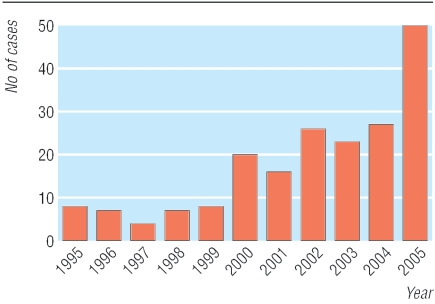Editor—An increase in empyema thoracis complicating pneumonia in children was reported from the West Midlands in 19971 and has since been confirmed in several other centres in the United Kingdom, Europe, and North America. Most culture positive cases in the United States are related to infection with Streptococcus pneumoniae serotype 1.2 This is also the most common causative organism in the UK where most cases are culture negative as shown by using pneumococcal polymerase chain reaction and serotype specific enzyme linked immunosorbent assays.3 Until recently, serotype 14 was responsible for most invasive pneumococcal disease in UK children, so the dominant serotype seems to have shifted considerably.
We have observed a further progressive increase in cases since 1997; over the past 12 months the number of cases requiring surgical intervention nearly doubled, to 48 per year. The figure shows the numbers of children requiring surgical intervention who represent 90% of total referrals to our regional centre. Our referral practice and our management policy have not changed over the past decade. In some of our cases the severity of the underlying pneumonic process seems to have increased, with associated lung necrosis and cavitation.4
The UK government recently announced the introduction of universal paediatric vaccination with the heptavalent pneumococcal conjugate vaccine suitable for use in infants. This vaccine does not contain antigen for serotype 1. Introduction of this vaccine to the United States in 2001 has been associated with a substantial decline in overall pneumococcal invasive disease but an increase in empyema cases in children, with a doubling of cases between 2000 and 2005 compared with the previous five years in one major centre.5 The causative organisms responsible for this increase include serotypes 1, 3, and 19a, as well as other non-vaccine serotypes. A causal relation between vaccination and this increase has not been proved, but this possibility cannot be dismissed, and it is likely that the incidence of this problem will now increase yet further in the UK.
Figure 1.
Numbers of surgically managed cases of empyema in northeast England, 1995-2005
We are pleased that the Health Protection Agency will introduce an enhanced programme of pneumococcal surveillance for paediatric empyema in England and Wales, including polymerase chain reaction and serotyping in culture positive and culture negative cases. This will allow for close monitoring of the problem on a national basis.
Competing interests: None declared.
References
- 1.Rees JMH, Spencer DA, Parikh D, Weller P. Increase in incidence of childhood empyema in West Midlands, UK. Lancet 1997;349: 402. [DOI] [PubMed] [Google Scholar]
- 2.Byington CL, Spencer LY, Johnson TA, et al. An epidemiological investigation of a sustained high rate of pediatric parapneumonic empyema: risk factors and microbiological associations. Clin Infect Dis 2002;34: 434-40 [DOI] [PubMed] [Google Scholar]
- 3.Eastham KM, Freeman R, Kearns AM, et al. Clinical features, aetiology and outcome of empyema in children in the north-east of England. Thorax 2004;59: 522-5. [DOI] [PMC free article] [PubMed] [Google Scholar]
- 4.Ramphul N, Eastham KE, Freeman R, et al. Cavitatory lung disease complicating empyema in children.. Pediatr Pulmonol (in press). [DOI] [PubMed]
- 5.Byington CL, Korgenski K, Daly J, Ampofo K, Pavia A, Mason EO. Impact of the pneumococcal conjugate vaccine on pneumococcal parapneumonic empyema. Pediatr Infect Dis J 2006;25: 250-4. [DOI] [PubMed] [Google Scholar]



